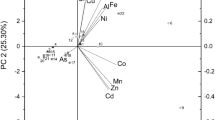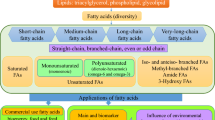Abstract
Cyathophorella adiantum (Griff.) M. Fleisch. (Division-Bryophyta, Family-Daltoniaceae), an Eastern Himalayan moss was studied for the first time to identify the volatiles derived from cellular and membrane bound fatty acids. A high capacity sample enrichment probe (SEP) was used for extraction of headspace volatile (HSV) molecules followed by GC–MS analysis. Different short-chain oxylipins like alkenes, alkanes, saturated and unsaturated alcohols, saturated and unsaturated aldehydes, ketones were identified along with free and esterified fatty acids, cyclo compounds and some by-products of secondary metabolites. Fatty acid analysis of neutral lipids (NL) and phospholipids (PL) of this plant exhibits the predominance of C16 and C18 fatty acids. It also reveals some interesting information that might indicate the possible fatty acid precursors for volatile generation and their sources in this plant.



Similar content being viewed by others
Abbreviations
- FA:
-
Fatty acid(s)
- FAME:
-
Fatty acids methyl ester(s)
- HSV:
-
Headspace volatile(s)
- LOX:
-
Lipoxygenase
- NL:
-
Neutral lipid(s)
- PL:
-
Phospholipid(s)
- PDMS:
-
Polydimethylsiloxane
- PUFA:
-
Polyunsaturated fatty acid(s)
- SEP:
-
Sample enrichment probe
References
Blee E (1998) Biosynthesis of phytooxylipins: the peroxygenase pathway. Fett 100(4–5):121–127
Feussner I, Wasternack C (2002) The lipoxygenase pathway. Ann Rev Plant Biol 53:275–297
Mosblech A, Feussner I, Heilmann I (2009) Oxylipins: structurally diverse metabolites from fatty acid oxidation. Plant Physiol Biochem 47:511–517
Hamberg M, Ponce-de-Leon I, Rodriguez MJ, Castresana C (2005) α-Dioxygenases. Biochem Biophys Res Commun 338:169–174
Farmer EE, Almeras E, Krishnamurthy V (2003) Jasmonates and related oxylipins in plant responses to pathogenesis and herbivory. Curr Op Plant Biol 6:372–378
Wasternack C (2007) Jasmonates: an update on biosynthesis, signal transduction and action in plant stress response, growth and development. Ann Bot 100:681–697
Dembitsky VM (1993) Lipids of bryophytes. Prog Lipid Res 32:281–356
Zinmeister HD, Mues R (eds) (1990) Bryophytes: their Chemistry and Chemical Taxonomy. Clarendon Press, Oxford
Asakawa Y (1990) Biologically active substances from Bryophytes. In: Chopra RN, Bhatla SC (eds) Bryophyte Development: Physiology and Biochemistry. CRC Press, Boca Raton, pp 259–287
Asakawa Y (1995) Chemical constituents of the bryophytes. In: Herz W, Kirby WB, Moore RE, Steglich W, Tamm Ch (eds) Progress in the Chemistry of Organic Natural Products, vol 65. Springer, Vienna, pp 1–618
Karunen P (1982) Possible evolutionary significance of galactolipid fatty acids in Bryophyta. J Hattori Bot Lab 53:255–269
Dembitsky VM, Rezanka T (1995) Distribution of diacylglycerylhomoserine, phospholipids and fatty acids in thirteen moss species from Southwestern Asia. Biochem Sys Ecol 23(1):71–78
Bottcher C, Pollmann S (2009) Plant oxylipins: plant responses to 12-oxo-phyto dienoic acid are governed by its specific structural and functional properties. FEBS J 276:4693–4704
Gerwick WH (1994) Structure and biosynthesis of marine algal oxylipins. Biochem Biophys Acta 1211(3):243–255
Pohnert G, Boland W (2002) The oxylipin chemistry of attraction and defense in brown algae and diatoms. Nat Prod Rep 19:108–122
d’Ippolito G, Lamari N, Montresor M, Romano G, Cutignano A, Gerecht A, Cimino G, Fontana A (2009) 15S- lipoxygenase metabolism in the marine diatom Pseudo-nitzschia delicatissima. New Phytol 183:1064–1071
Rempt M, Pohnert G (2010) Novel acetylenic oxylipin from the moss Dicranum scoparium with antifeeding activity against herbivorous slugs. Angew Chem Int Ed 49:4755–4758
Asakawa Y, Ludwiczuk A, Nagashima F (2012a) Phytochemical and biological studies of bryophytes. Phytochem http://dx.doi.org/10.1016/j.phytochem.2012.04.012
Bukvicki D, Gottardi D, Veljic M, Martin PD, Vannini L, Guerzoni ME (2012) Identification of volatile components of liverwort (Porella cordaeana) extracts using GC/MS-SPME and their antimicrobial activity. Molecules 17:6982–6995
Li L, Zhao J (2009) Determination of the volatile composition of Rhodobryum giganteum (Schwaegr.) Par. (Bryaceae) using solid-phase microextraction and gas chromatography/mass spectrometry (GC/MS). Molecules 14:2195–2201
Mues R (2000) Chemical constituents and biochemistry. In: Shaw AJ, Goffinet B (eds) Bryophyte Biology. Cambridge University Press, Cambridge, UK
Qiao F, Ma SC, Lin RC, Kong LY (2004) GC-MS analysis of essential oil of Rhododendron giganteum. J Chin Pharm 39:704–706
Bai XW, Song CH, You JM, Sun ZW, Fu YY, Liang G (2010) Determination of fatty acids (C1–C10) from bryophytes and pteridophytes. Chromatographia 71:1125–1129
Gangulee HC (1977) Mosses of Eastern India and adjacent regions: A monograph, Fac.6. Calcutta, India
Gangulee HC (1985) Handbook of Indian Mosses. Amerind Publishing, New Delhi, India
Bligh EG, Dyer WJ (1959) A rapid method of total lipid extraction and purification. Can J Biochem Physiol 37:911–917
Poddar-Sarkar M (1996) The fixative lipid of tiger pheromone. J Lipid Med Cell Sig 15:89–101
Burger BV, Marx B, Roux M, Burger WJG (2006) Simplified analysis of organic compounds in headspace and aqueous samples by high-capacity sample enrichment probe. J Chromatogr A 1121:259–267
Ozdemir T, Yayn N, Cansu TB, Volga C, Yayn N (2009) Essential oils in mosses (Brachythecium salebrosum, Eurhynchium pulchellum and Plagiomnium undulatum) grown in Turkey. Asian J Chem 21:5505–5509
Matsui K (2006) Green leaf volatiles: hydroperoxide lyase pathway of oxylipin metabolism. Curr Op Plant Biol 9:274–280
Noordermeer MA, Veldink GA, Vliegenthart, JF (2001) Fatty acid hydroperoxide lyase: a plant cytochrome P450 enzyme involved in wound healing and pest resistance. ChemBioChem 2:494–504
Croft K, Jüttner F, Slusarenko AJ (1993) Volatile products of the lipoxygenase pathway evolved from Phaseolus vulgaris (L.) leaves inoculated with Pseudomonas syringae pv phaseolicola. Plant Physiol 101:13–24
Gomi K, Yamasaki Y, Yamamoto H, Akimitsu K (2003) Characterization of a hydroperoxide lyase gene and effect of C6-volatiles on expression of genes of the oxylipin metabolism in Citrus. J Plant Physiol 160:1219–1231
Zeringue HJ (1992) Effects of C6–C10 alkenals and alkanals on eliciting a defense response in the developing cotton ball. Phytochem 31:2305–2308
Croisier E, Rempt M, Ponhert G (2010) Survey of volatile oxylipins and their biosynthetic precursors in bryophytes. Phytochem 71:574–580
Wichard T, Go¨bel C, Feussner I, Pohnert G (2005) Unprecedented lipoxygenase/hydroperoxidelyase pathways in the moss Physcomitrella patens. Angew Chem 44:158–161
Ucuncu O, Cansu TB, Ozdemir T, Alpaykaraoglu S, Yayli N (2010) Chemical composition and antimicrobial activity of the essential oils of mosses (Tortula muralis Hedw., Homalothecium lutescens (Hedw.) H. Rob., Hypnum cupressiforme Hedw., and Pohlia nutans (Hedw.) Lindb. from Turkey. Turk J Chem 34:825–834
Toyota M, Asakawa Y (1994) Volatile constituent of the liverwort Chiloscyphus pallidus (Mitt.) Engel & Schuster. Flav Fragr J 9:237–240
Saritas Y, Sonwa MM, Hassan I, Ko¨nig WA, Muhle H, Mues R (2001) Volatile constituents in mosses (Musci). Phytochem 57:443–457
Spiteller D, Spiteller G (2000) Direkter Nachweis von toxischem 2,4-Decadienal in oxydiertem Low-Density-Lipoprotein durch Fest-phasenextraktion. Angew Chem 112:595–597
Asakawa Y, Ludwiczuk A, Nagashima F (2012) Chemical Constituents of Bryophytes: bio- and Chemical Diversity, Biological Activity and Chemosystematics. In: Kinghorn DA, Falk H, Kobayashi J (eds) Progress in the Chemistry of Organic Natural Products, vol 95. Springer, Vienna, pp 1–760
Stumpe M, Bode J, Go¨bel C, Wichard T, Schaaf A, Frank W, Frank M, Reski R, Pohnert G, Feussner I (2006) Biosynthesis of C9-aldehydes in the moss Physcomitrella patens. Biochim Biophys Acta 1761:301–312
Matsui K, Kurishita S, Hisamitsu A, Kajiwara T (2000) A lipid-hydrolysing activity involved in hexenal formation. Biochem Soc Trans 28:857–860
Gellermann JL, Anderson WH, Richardson DG, Schlenk H (1975) Distribution of arachidonic and eicosapentanoic acids in the lipids of mosses. Biochim et Biophys Acta 388(2):277–290
Gardner HW, Grechkin AN (2002) Biocatalysis by the Plant Lipoxygenase Pathway: Oxygenated Fatty Acid production and Hydroperoxide Lyases. In: Kuo TM, Gardner HW (eds) Lipid Biotechnology. CRC Press, London UK
Bouarab K, Adas F, Gaquerel E, Kloareg B, Salaun J, Potin P (2004) The innate immunity of a marine red alga involves oxylipins from both the eicosanoid and octadecanoid pathway. Plant Physiol 135(3):1838–1848
Weber H (2002) Fatty acid derived signals in plants. Trends Plant Sci 7(5):217–224
Acknowledgments
We heartily acknowledge the kind assistance from The Programme Co-ordinator, Centre of Advanced Study and the Head of the Department of Botany for giving us infrastructural support. We are thankful to the Department of Science and Technology, the Government of West Bengal for funding. We deeply acknowledge the UGS-CAS and DST-FIST programme, Government of India for providing us with instrument facilities. We are grateful to Dr. Lopamudra Saha, Assistant Professor of the University of Kualu-Zulu, South Africa and Dr. Eke Zsuzsanna, Kramarics Aron of the Department of Chemistry, Eotvos Lorand University, Hungary for assisting us in many ways. We are indebted to the scientists who have given us their valuable time for critically reviewing this article.
Conflict of interest
The authors declare that there is no conflict of interest.
Author information
Authors and Affiliations
Corresponding author
Electronic supplementary material
Below is the link to the electronic supplementary material.
About this article
Cite this article
Mitra, S., Burger, B.V. & Poddar-Sarkar, M. Headspace Volatile Oxylipins of Eastern Himalayan Moss Cyathophorella adiantum Extracted by Sample Enrichment Probe. Lipids 48, 997–1004 (2013). https://doi.org/10.1007/s11745-013-3807-1
Received:
Accepted:
Published:
Issue Date:
DOI: https://doi.org/10.1007/s11745-013-3807-1




